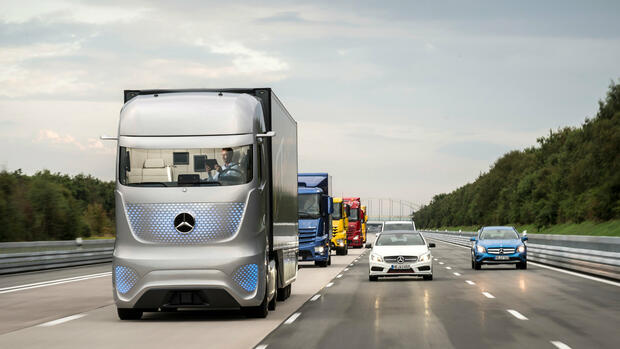Duisburg Driverless autonomous driving on public roads should actually be ready for series production in trucks even earlier than in cars. The high acquisition costs for intelligent cameras, radar and laser scanners (lidar) should be amortized more quickly for commercial customers. But these expectations have apparently not been fulfilled.
The hype surrounding autonomous driving has cooled in the truck industry. “After the initial euphoria, the entire industry is currently in a phase of disillusionment,” said ZF commercial vehicle boss Peter Laier on the sidelines of the Automotive Logistics conference in Duisburg. His company claims to be the world’s largest supplier of commercial vehicles.
The development of self-driving trucks is continuing, but in smaller steps. And it will take longer than originally predicted just a few years ago.
Because systems referred to as Level 3 and 4 require high investments. Only they allow the driver to temporarily take his hands off the wheel. “If, for example, the legislature were to allow longer driving times for drivers, then the economic incentive to develop and use such systems for series production would be significantly higher,” emphasizes Laier.
Suppliers currently have little leeway when it comes to development budgets. In particular, the high costs of the transformation to electromobility are a burden. Savings are being made elsewhere: ZF and Bosch actually wanted to develop and build the Lidar radar system themselves. The suppliers have put these plans on hold.
“Companies need planning security,” emphasized ZF board member Laier. But that doesn’t exist in many areas at the moment – neither for automated driving, nor for the types of drive and the associated emissions, nor for data security. “We need sensible and consistent political guidelines in the EU,” says Laier. Politicians must create incentives and remain open to technology instead of relying on new bans.
>> Also read: German auto suppliers are falling behind: Bosch is giving up development of lidar sensors
The ZF board is not alone in its criticism. “Constantly new regulations prevent innovation,” says Daimler Truck boss Martin Daum. “If everyone just sticks to the guidelines, we won’t get any further.” Daum has repeatedly emphasized that it will take at least until the end of the decade before Daimler trucks are fully automated. However, it is uncertain whether this schedule will work.
Given the limited resources, ZF also wants to prioritize the components that promise the greatest success. These are currently orders for the electric drive train with a volume of five billion euros, as confirmed by ZF board member Laier. In the commercial vehicle division, too, the electrical orders should ensure that the division grows disproportionately this year. Last year, the newly formed division achieved sales of 7.5 billion euros.
Platooning is considered a failure for the time being
The example of platooning shows how difficult the path to self-driving trucks is. With this technology, several semi-autonomous trucks join together to form a convoy and communicate with each other via a shared WLAN. Just five years ago, the transportation industry had high hopes for platooning as a way to get rising costs and an acute driver shortage under control.
The supplier is demanding clearer political guidelines.
(Photo: imago images/photothek)
Only the vehicle in front is controlled, while the other trucks follow using computer technology. As soon as they have joined the group, which experts refer to as a “platoon” based on military terms, the vehicles behind automatically stay in the lane. Their computer systems measure the respective distance and brake immediately as soon as the speed is reduced. Because the trucks drive at a distance of only 15 meters – the German road traffic regulations require a minimum distance of 50 meters for standard trucks – driving in the slipstream should also save diesel.
With such a reduced distance, networked convoys commuted on the A 9 between Munich and Nuremberg for nine months in 2018. The truck manufacturer MAN, the freight forwarding company DB Schenker and the Fresenius University of Applied Sciences were involved. But the results were disappointing: the testers recorded a fuel saving of just three to four percent because the platoon had to be reassembled after each motorway exit. The catching up of the rear trucks increased diesel consumption.
>> Also read: Scania opens battery assembly – but VW’s truck subsidiary is struggling with the electric transition
By the end of 2021 at the latest, after the EU had funded platooning tests with more than 20 million euros, most logistics experts declared the idea a failure. Daimler Trucks had previously drawn a line under a test procedure in the USA. The truck manufacturer said there was no business model for platooning. One of the reasons: Because the semi-autonomous trucks made a driving error on average every 2,000 kilometers, the following trucks also have to be staffed with drivers. Personnel costs are therefore reduced moderately at best.
A study by the University of Western Australia also came to the conclusion that semi-autonomous trucks often created significant gaps on highways in order to create the necessary safety distance. This often triggered a stop-and-go wave, the researchers found in 2021.
Accordingly, truck technicians are now increasingly relying on autonomous vehicles. But here too, development is rather slow. The Swedish start-up Einride received permission in its home country to use public roads for DB Schenker in 2019, and the US authority NHTSA also granted Einride such permission in mid-2022. But for safety reasons, the electric vehicles without a driver’s cab rarely travel faster than walking speed. Rain and fog also disrupt automatic orientation.
Even Google subsidiary Waymo, which is testing driverless trucks together with Daimler, declared two months ago that it wanted to concentrate on autonomous taxis in the future.
More: Mercedes wants to outdo suppliers
